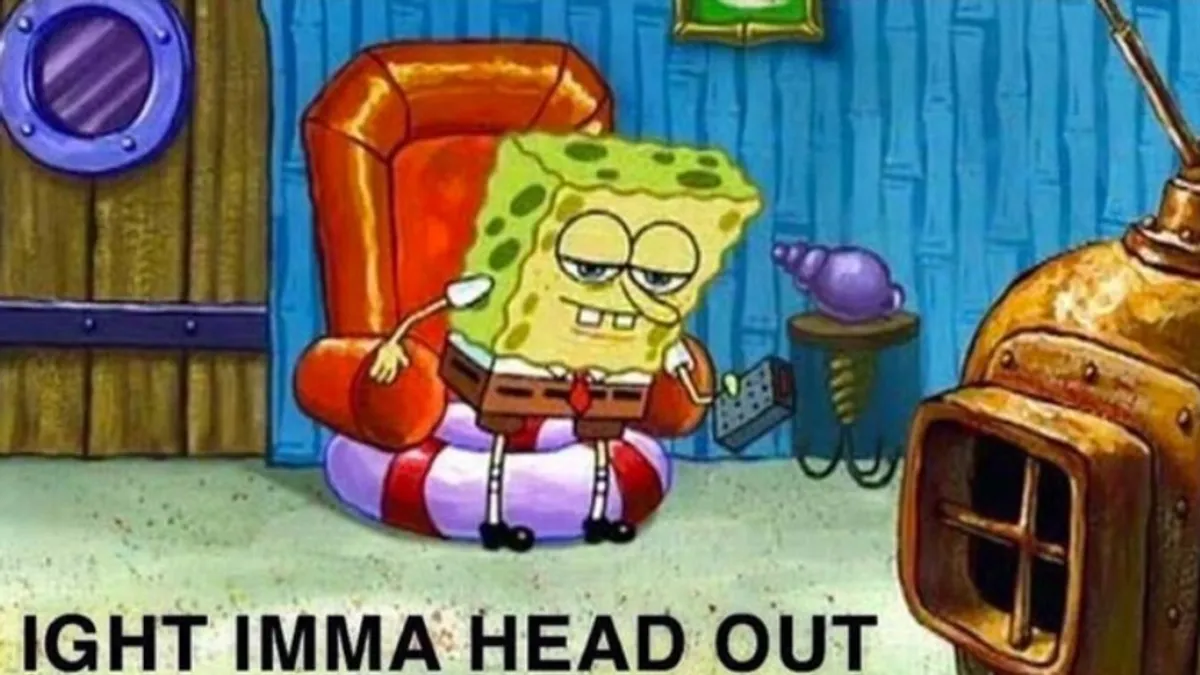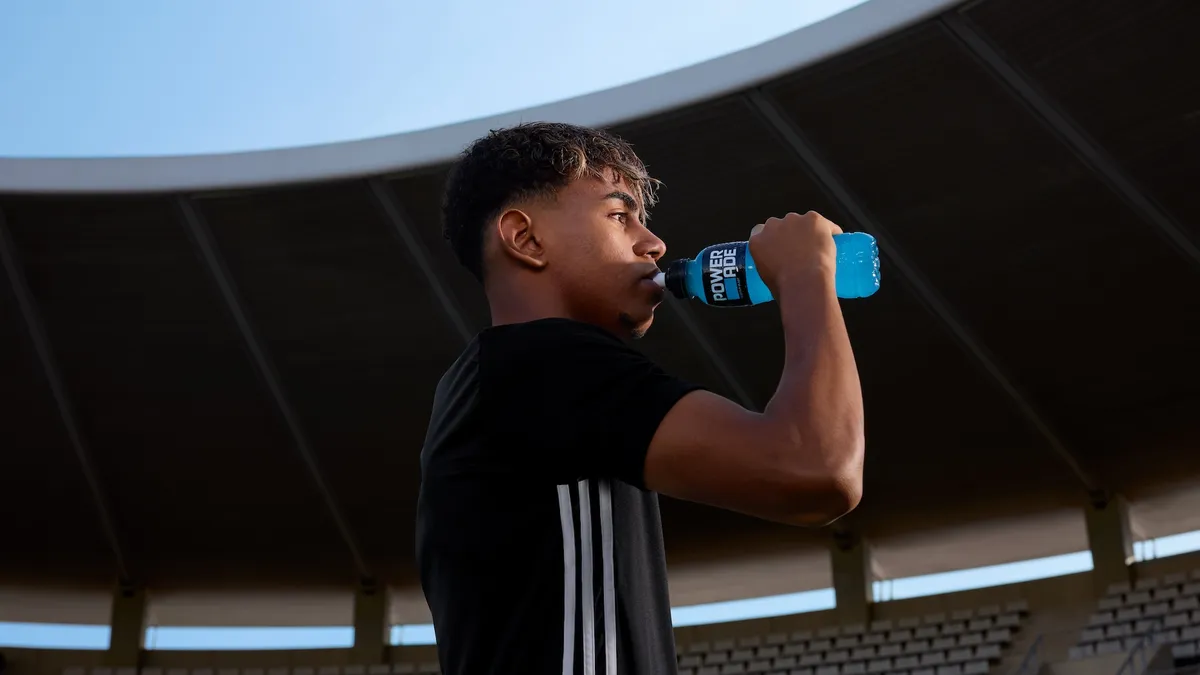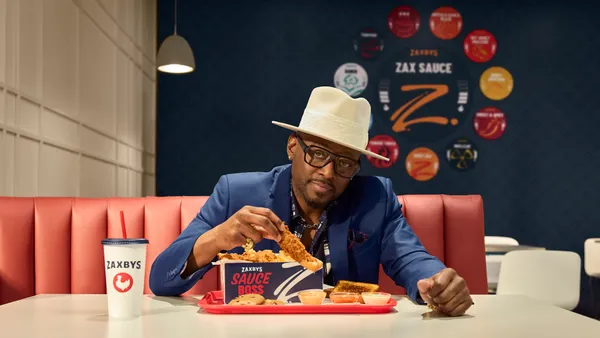SpongeBob SquarePants does not look happy. Eyes downcast, listlessly holding a remote control, the animated character is pictured rising out of his armchair. The caption reads, "When someone casually says dressing for Halloween is stupid..." above SpongeBob's response, "ight imma head out."
This is just one recent example of an Instagram post shared by Tipsy Elves, a brand that specializes in holiday-themed sweaters and other clothing. Although the post is part of the brand's larger social media marketing strategy, its name and products are nowhere to be seen. Instead, the post capitalizes on a popular meme from the past few months, turning SpongeBob into the brand's pseudo-spokesperson along the way.
Tipsy Elves' strategy aims to grab the attention of social-savvy consumers with humorous, thumb-stopping posts that match the brand's voice and drive people to its online shop, CEO and co-founder Evan Mendelsohn told Marketing Dive.
"Our mission statement is that we make outrageous apparel to transform moments that matter into unforgettable memories, and we're always trying to figure out the voice that resonates best for our gear," Mendelsohn said. "With social in particular, we've decided to leverage memes as a medium or vehicle to get our message across in a shareable, engaging format."
Defining 'meme'
Coined by British biologist Richard Dawkins in 1976 to describe an "imitated thing," a meme's modern definition is wide-ranging. A 2017 study from the University of Budapest characterizes a meme as images, video or text that references popular culture and is designed to be repurposed. This includes creations by both consumers and brands.
Using a meme can help brands demonstrate that they're on the same page as target audiences and appeal to younger consumers, according to Juergen Dold, CEO of creative agency Optimist Inc.
"Within a three- to five-second timeframe, you can get across a really culturally loaded and expressive message," Dold told Marketing Dive. "You can also now connect individuals or fans who might be part of a particular subculture into your campaign, which makes it personal, and that's why it's a really interesting tool."
It's no secret that brands have grown comfortable dishing out direct, bold jabs at competitors on social media over the past few years. These brand feuds have driven results for Wendy's and other companies known for their off-the-cuff candor. Now, social media sass is mainstream, forcing brands to explore fresh ways to spark similar buzz by showing some personality and wedging into cultural conversations online.
"The sweet spot between overwhelming an audience and being funny is very small."

Andrew Browne
Owner, Browne Box Creative
Capitalizing on meme culture can take a brand's social presence to the next level by authentically connecting to a younger audience, Andrew Browne, owner of a social media marketing and analysis firm Browne Box Creative, told Marketing Dive.
"When a brand knows their target audience and the appropriate voice and tone to use for that audience, they can choose appropriate memes as a part of their strategy and messaging to see an increase in engagements," he said. "The sweet spot between overwhelming an audience and being funny is very small."
'Lo-Fi' but powerful
There's a growing list of case studies showcasing major brands tapping memes to capitalize on pop culture buzz and insert themselves into social media chatter.
Oliver Yonchev, U.S. managing director of Social Chain agency, pointed to Twitter, which played up its rivalry with Instagram by creating a catalog of Instagram posts that were simply screen captures of tweets. Gucci commissioned artists in 2017 to create memes featuring its wristwatches as part of a "That Feeling When Gucci" campaign to promote its new line of watches and position itself as a more accessible luxury brand.
"Brands have sometimes struggled with the idea that these are low-fi pieces of creative that aren't branded, and which may be beyond the spectrum of their brand guidelines and touching on interests that are outside of their comfort zone," Yonchev told Marketing Dive.
For marketers whose memes highlight their brands' strong self-awareness and trust in audiences, the pay off can be significant.
"You've almost got a sure-fire piece of creative you know is going to be successful," Yonchev added.
Typically, finding the right formula for memes is easier said than done. According to Casey Soulies, director of digital media at MeringCarson, brands that are slow to act are often too late, as social media conversations can shift in a matter of days or hours. In addition to the need for timeliness, memes must also be part of a consistent strategy that fits the brand.
"I feel like they're part of an open-source culture where everyone reiterates on them and puts their own stamp on them."

Katy Lucey
Director of paid social, Tinuiti
"It can't be selective or one-time only," he said. "You either rare in it and it's a part of who you are... or you're not. Right now, we would advise most of our clients not to participate."
Brands should also consider whether a meme reflects their authentic voice and prepare for things to take unexpected turns, said Katy Lucey, agency Tinuiti's director of paid social.
"They want to capitalize on that virality, and we'll push back and say, 'We hear you, but it might rub our customers the wrong way.' We don't want our marketing to backfire in terms of causing troll-like conversions in the comments," she said.
Legal question marks
Beyond sharing a meme that might create negative feedback or simply fall flat, brands must tread carefully around how they use existing intellectual property (IP) from movies, films and other sources.
Average consumers who share memes are largely protected under "fair use" principles in trademark law, per a recent article by Gary Reed Attorneys & Counselors. Much depends on how aggressively a copyright or trademark holder chooses to enforce their rights, particularly when a meme is being used for commercial purposes like marketing.
Social platforms, meanwhile, may be wary of hosting such content. In July, for instance, digital advocacy group Reclaim The Net reported that Instagram shut down more than 30 meme-focused accounts. Facebook, which owns Instagram, said it acted because the accounts violated its terms of use. While the company didn't specifically cite copyright or trademark concerns, Reclaim The Net suggested one of the issues might have been that memes were used without proper permission.
Lucey said this is why Tinuiti avoids images with content from SpongeBob, "The Office" or similar widely appropriated content that might be trademarked, despite how memes have generally become the internet's collective work that's repeatedly altered and shared.
"I feel like they're part of an open-source culture where everyone reiterates on them and puts their own stamp on them," Lucey said.
Tipsy Elves' Mendelsohn says his firm uses a third-party service to manage approvals for anything that might require licensing or permission to be used for commercial purposes. In other cases, it's simply a matter of ensuring the owner of the original IP is properly cited.
"The going advice — all the legal advice we've gotten — is to make sure we're giving credit," he said.
Marketers can work with their creative teams or agency partners to create original memes, of course, but they likely won't become as viral as those already circulating online. Another option is to work with platforms like 9Gag, a Hong Kong-based site for sharing this type of UGC. 9Gag announced earlier this month that it's launching a media and marketing platform to drive advertising revenue and offer brands custom content, licensing and distribution.
"A meme a day will keep your customers away."

Laura Russell
Director of strategy, Adlucent
Russell Schneider, 9Gag's general manager and EVP of partnerships and business development, said his team regularly works with brands to more safely use or develop memes. Even there, however, pitfalls emerge.
"The problem is when [brands] want to make something too commercial-oriented," he told Marketing Dive. "We'll come up with an idea, and the brand will say, 'Can we make sure Creator X, in this short-form video production, mentions our brand name eight times?'"
Schneider suggests marketers instead begin with clear goals and objectives for a social media campaign before exploring how memes could support it. Memes should be part of a phased approach to a campaign rather than something fired out all at once, he said.
An exercise in social listening
Working with memes may be less of a marketing tactic and more of a skill set that involves observing what's trending among key consumers and aligning those topics with a brand's messaging.
Laura Russell, director of strategy at Adlucent, noted how the Saatva mattress brand used the tagline "What if the only thing that 'sparks joy' is more sleep?" around the time Marie Kondo's book and Netflix series — which are focused on the author's ideas around how to "spark joy" — became popular.
This was a savvy way to add relevant and timely wittiness without breaking Saatva's brand voice, she said. However, memes won't work for every situation or for brands in certain categories.
"A pharmaceutical company sharing a meme may not resonate the same as one circulated by a fast food chain," she said, adding that even if a meme is original and clever, marketers should avoid overdoing it.
"A meme a day will keep your customers away," Russell stated.






















